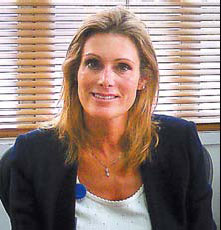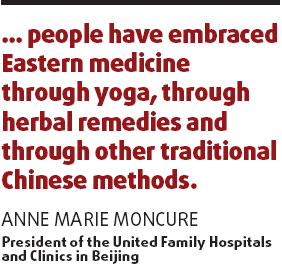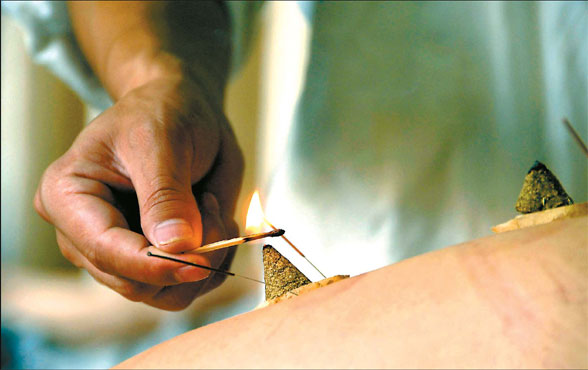East or West? Both works best
|
TCM practices, such as acupuncture and moxibustion, have become increasingly popular in the West. Zhang Tianlin |
Basketball star Yao Ming's injury dramas have helped shine the spotlight on traditional Chinese medicine (TCM), an ancient practice used by more and more people around the globe. Yao says he will use TCM as well as Western medicine to help his recovery in the lead-up to the Beijing Olympics. He is desperate to be fit for the biggest tournament of his life.
According to the President of the United Family Hospitals and Clinics, Anne Marie Moncure, the combination of Eastern and Western medical techniques is the best option for resuscitating Yao Ming's stress fracture.
"He should, first of all, re-build the body and ensure that the injury doesn't happen again, and then if he has to repair an injury I would say maybe that's where Western medicine comes in," Moncure says, drawing on her 35 years of medical experience.
While it's not her professional diagnosis, Moncure is certain that combining the two is the best option. "I wouldn't choose one over the other; if I were him I would incorporate both," the 52-year-old New Yorker says.

Fusing Western medical practices, which focus more on treating short-term injuries through medication, and TCM practices, which are all about building strength and developing a balance in the body, is what Moncure views as the best way to treat almost any injury.
"I call it integrative medicine, where you take the best of both worlds," she says.
Moncure began her medical career working alongside one of the most prominent doctors of her time, Denton Cooley. Cooley is known for his leading-edge medical techniques after he became the first man in the United States to successfully complete a heart transplant in 1968.
It was during her time working with Dr Cooley at the Texas Heart Center in 1982 that Moncure first witnessed the power of Eastern medicine.
After discovering that one of their patients had a strong negative reaction to anesthesia, Moncure and her fellow pioneers at the Texas Heart Center decided to take an unconventional approach. They flew in a TCM practitioner, who used acupuncture in place of anesthesia. The patient felt no pain and the operation proved to be a smashing success.
Witnessing first hand the power of Eastern medical practices opened Moncure's eyes and mind to TCM. Several years later, after feeling unnatural levels of fatigue, Moncure decided to use the technique on herself.
Enlisting the help of two doctors scripted in Western medicine and TCM she recalls how well both methods seemed to mix and match.
"I watched the two of them work so well together, we blended both styles, and I am convinced that that's the only way to go," Moncure says.
The success of the treatment was so convincing that she recently began developing a branch in the United Family Hospitals and Clinics in Beijing devoted to the fusion of traditional Chinese and Western medicines. A branch she appropriately calls Integrative Medicine.
"We're in China, why not bring the two worlds together?" she says.
But medicine from the East has not always been viewed so openly in the United States. In 1989, while taking pictures of a hospital she was working at in Charlotte, North Carolina, Moncure remembers running into a patient being treated by Eastern medicine.
"There was this glistening up and down her back, it was acupuncture needles, and she looked almost like a peacock or something," says Moncure.
She says she did not use any of the photos of the procedure, because she feared that the unusual image would baffle the local community.

Such misunderstanding no longer exists in the US. "Now Eastern medicine is a multi-billion dollar industry in the US, people have embraced Eastern medicine through yoga, through herbal remedies and through other traditional Chinese methods," Moncure says.
She first arrived in China two years ago after spending several years in India helping develop the infrastructure for the Indraprastha Apollo Hospital as a manager for the Indraprastha Medical Co Ltd.
Under her direction, the hospital became the first Joint Commission International-accredited hospital in India.
With more than 20 years of managerial experience, Moncure has spent time working as a medical leader in the US, UK, India, France and Switzerland.
Recently, Moncure and an army of well-trained phlebotomists from the United Family Hospitals and Clinics network, in association with the Chaoyang blood administration, held a blood drive at the Expat Show that took place in the China World Trade Center exhibition hall.
Their goal, apart from building up pre-Olympic blood bank supplies, was to find RH negative donors. It is estimated that only 0.03 percent of Han Chinese are RH negative, compared to 15 percent of Western populations.
Attempts to stockpile valuable medical resources such as RH negative blood are being seen more and more as the medical community gears up for the rush of foreign crowds during the Olympic Games.
Moncure says the Chinese medical community is well prepared for the upcoming Games.
"For the Olympics, I think that the biggest challenge is going to be that we have communication. We should be able to communicate with the patients coming in," she says.
For the United Family Hospitals, however, the ability to speak and communicate with patients should not pose a problem. The hospital's medical providers, in addition to English, Spanish, French, German, and Arabic, are well versed in most Chinese dialects. For the less common languages, the hospital employs the use of several interpretation services.
(China Daily 04/18/2008 page19)















